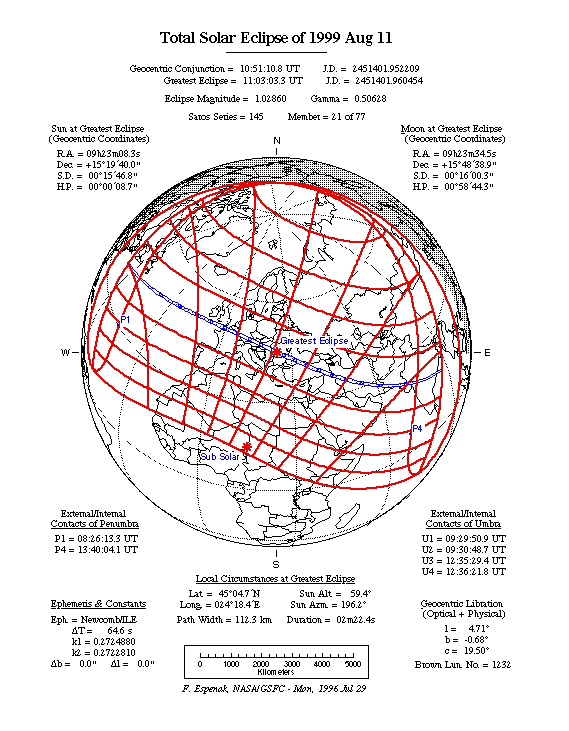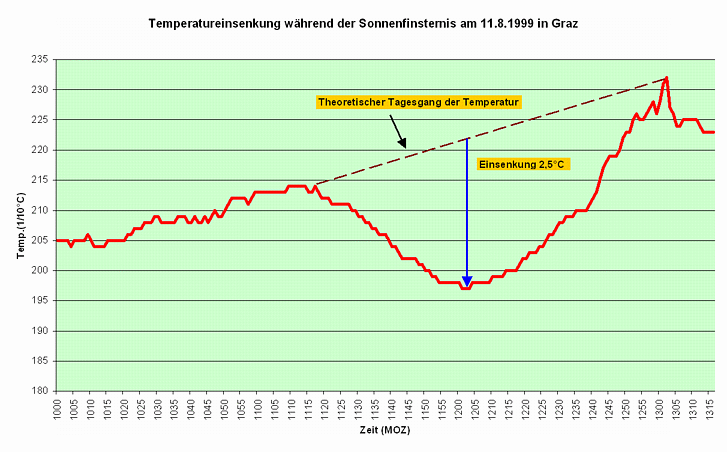A solar eclipse
|
B. Geerts |
3/’02 |
What is an eclipse?
An eclipse occurs at those times when the Moon moves into a position of direct alignment with the Sun and the Earth. There are two basic types of eclipses –lunar and solar. Most people have seen at least one total lunar eclipse, when the full Moon passes through the shadow of the Earth. In this case, the Sun and the Moon are on opposite sides of the Earth. If you observe a lunar eclipse (visible only at night at the time of certain full Moons), you’ll see the bright lunar disk turn dark for as long as an hour or more.
A total solar eclipse occurs when the new Moon passes directly between the Sun and the Earth (Fig 1). In the narrow path of 'totality' swept across the Earth by the Moon’s complete shadow (the umbra), daytime briefly turns to an eerie darkness, and during these few precious minutes the corona of the Sun comes into view as the dark disk of the Moon totally obscures the bright Sun. Protuberances rising from the chromosphere may be seen as well. Outside the path of totality, in the Moon’s partial shadow (the penumbra), some portion of the Sun’s bright disk remains visible (Fig 2).

Fig 1. Schematic positions of Sun, Moon and Earth in a total solar eclipse.
Not all solar eclipses are total. During a partial solar eclipse, only the penumbra touches our planet. The umbra passes either just above the North Pole or just below the South Pole, completely missing the Earth. Or it is possible that the Moon is further removed in its orbit around the Earth, so that its umbra is not quite long enough to touch the surface: the shadow cone diminishes to a point before reaching the Earth. In this case the partial eclipse is annular (Latin for "ring") in shape. Eclipses occur at somewhat periodic intervals, yet the eclipse cycle does not correspond with the annual cycle.

Fig 2. Sequence of events during a total solar eclipse. The period from first to last contact may last an hour or more, but total obscuration only lasts a few minutes.
The eclipse of 11 August 1999
The geometry of the August 11, 1999, total solar eclipse is shown in Fig 3. A visible satellite image of Europe at the time of the eclipse is shown in Fig 4. This appears to be a nighttime picture, but there is daylight in all four directions away from western Europe, which is largely dark because of the penumbra. The umbra itself is a small circle (about 1° x1° ) in the Channel between England and France. At any location total darkness lasted just over 2 minutes.

Fig 3. The total solar eclipse of August 11, 1999. The path of totality (umbra) is shown in blue and the extent of the penumbra in red. Source: (1).

Fig 4. Visible Meteosat image at 10:30 UTC on August 11, 1999.
Solar eclipse and screen temperatures
When a solar eclipse occurs around noon, as it did in central Europe on August 11, 1999, it causes a dramatic change of the surface energy balance. The net radiation suddenly declines to small or even negative values, resulting in a drop of ground temperature, and to a lesser extent, a drop of air temperature. A 70 - 80% eclipse of the Sun at 35-46° N across the USA on 10/5/94 resulted in a temporary fall of observed screen temperatures by up to 6 K (2). A numerical simulation of the atmospheric boundary layer and land-air interaction shows good correspondence between observed and modeled cooling rates.
The cooling rate during an eclipse depends on cloudiness and the proximity to local solar noon. It is negligible when the sky is overcast, e.g. only 0.1 K at Plymouth, England on 11/8/99, but 3.0 K at Criquemanville, France on the same day, with part cloud. Other partly cloudy places that day were Munich, where the air cooled by 2.4 K, and Graz (Austria), where the cooling was 2.5 K (Fig 5). Larger cooling occurred at places with clear skies: Bucharest (5.5 K), Donchevo, Bulgaria (4.6 K), Elazig, Turkey (4.8 K), Batman, Turkey (11.1 K), Tiran, Iran (8.0 K). Other factors explaining these differences include wind speed (turbulent mixing), mixing layer depth, dryness of the ground, and the degree to which the eclipse was total or only partial. For instance, in Batman (Turkey) a complete eclipse occurred in the early afternoon under clear skies, calm winds, dry soil, and a shallow PBL (3).
The cooling is short-lived, and as soon as the Sun's exposure increases, the ground temperature increases again. The air above the ground takes longer to readjust. The total duration of subnormal screen-level temperature is 1-2 hours (Fig 5) (up to 2.5 hours at Hegyhatsal in Hungary on 11/8/99) (4).

Fig 5. Temperature trend during the eclipse of 11/8/99 in Graz (Austria). The temperature (y-axis) is in units of 0.1 ° C and the time (x-axis) in minutes (local time). The departure of the actual trend (red line) from the 'normal' trend (dashed line) is up to 2.5 K (from the Zentralanstalt fur Meteorologie und Geodynamik, Graz, Austria)
References
- The Sun-Earth connection education forum.
- Segal, M., R.W. Turner, J. Prusa, R.J. Bitzer and S.V. Finley 1996: Solar eclipse effect on shelter air temperature. Bull. Amer. Meteor. Soc., 77, 89-99.
- private communication from Laszlo Makra of the University of Szeged in Hungary.
- Hughes, D. 1999. Lights out. New Scientist, 163 (2198), 7th August, 48-49.